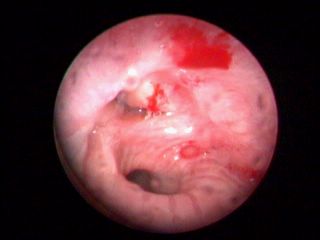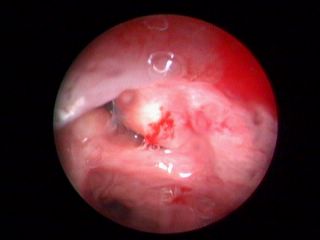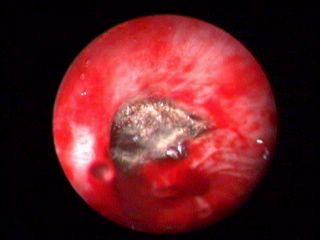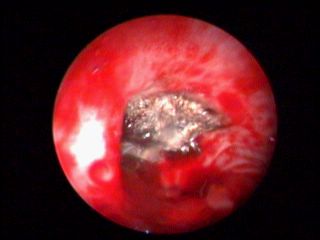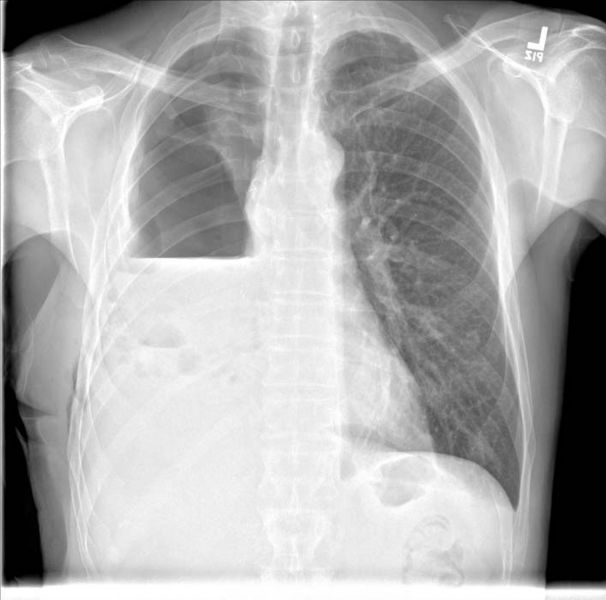Bronchopleural fistula
pEditor-In-Chief: C. Michael Gibson, M.S., M.D. [1] Associate Editor-In-Chief: Cafer Zorkun, M.D., Ph.D. [2]
Overview
A bronchopleural fistula (BPF) is a fistula between the pleural space and the bronchial tree. It is a sinus tract between the bronchus and the pleural space that may result from many reasons but most commonly following pneumectomy, or sometimes due to tumors at bronchial margin. It can also occur in response to chemotherapy, radiotherapy COpD, lymph node dissection, long term mechanical ventilation and infections. On imaging, the diagnosis is suspected indirectly on radiograph. Increased gas in the pneumonectomy operative bed, or new gas within a loculated effusion are highly suggestive of the diagnosis. Although radiograph can help in diagnosing it but CT gives a better picture.
It can present with acute or subacute symptoms. It presents with symptoms such as sudden onset dyspnea, chest pain, hemodynamic instability in acute setting. The subacute presentation shows up with emphysema, fever, malaise. Depending on how the patient presents, general suppprtive care and surgical repair are the treatment options.
Pathophysiology
Bronchopleural fistula can occur due to necrotising pneumonia/empyema (anaerobic, pyogenic, tuberculous, and fungal), lung neoplasms, blunt and penetrating lung injuries. It can also occur as a complication of procedures, such as lung biopsy, chest tube drainage, thoracocentesis or may complicate radiation therapy. Most commonly it occurs as a complication of lung surgery. When the bronchial stump fails to heal, a sinus tract is formed between bronchus and pleura, which causes continuous air leak into the pleura. This failure to heal can be from improper initial closure, inadequate blood supply, infection or residual malignant tumour at the bronchial stump.
Epidemiology and Demographics
The incidence of varies from 4.5% to 20% after pneumonectomy and 0.5% after lobectomy. Certain patient characteristics increase this incidence. preoperative radiation to the chest, destroyed or infected lung from inflammatory disease, immunocompromised or immunesuppressed host, diabetes, hypoalbuminemia, cirrhosis, steroid administration, pneumonectomy, right-sided pneumonectomy, a long bronchial stump, residual cancer at the bronchial margin, devascularization of the bronchial stump, prolonged ventilation, or reintubation after resection and surgical inexperience are the factors which may make patient more vulnerable to having BPF. The increased risk of BPF associated with right pneumonectomy is due to the need of more extensive resection required in right pneumonectomy. [1] Mortality rates varies between 18 percent to 67 percent in BPF. The most common cause of death is aspiration pneumonia and subsequent acute respiratory distress syndrome or development of tension pneumothorax.
Etiology
Bronchopleural fistula mostly develops after lung resection surgery. Some other causes of bronchopleural fistula are
- Right sided surgery[2]
- Chemotherapy and radiation
- Malignancies such as
- Lung cancer
- Thyroid cancer
- Esophageal cancer
- Lymphomas[3]
- Diabetes mellitus[4]
- Gastrointestinal causes such as
- Gastroesophageal reflux disease with Barrett esophagus
- Boerhaave syndrome
- Broncholithiasis
- Heavy smoking and COpD[5]
- Low nutritional status
- Residual tumor at bronchial margin
- Extensive lymph node dissection
- Traumatic and iatrogenic etiologies
- Thoracic trauma with tracheobronchial tree disruption
- Post-surgical (eg. lobectomy or lung biopsy) - by far the most common cause.
- Bougie intubation
- Necrotizing lung disease
- ARDS
- Ventilator-induced barotrauma
- Excessive manual ventilation
- Central line placement
- Complication of bronchoscopy
- Older age
- Long term postoperative mechanical ventilation specially following criteria predisposes patient to BPF
- High suction of the ICC
- High tidal volumes
- High inspiratory pressures
- Tuberculous[6] of fungal infection[7]. Other infections such as
- Haemophilus influenzae
- Streptococcus viridans
- Staphylococcus aureus
- Pseudomona aeruginosa
- Klebsiella pneumoniae
- Pneumococcus
- Nonhemolytic streptococcus
- Aspergillus
- Histoplasma capsulatum
Natural History And Classification
Cough and changes in the air-fluid pattern on chest radiograph after surgery are critical as warning signs of BPF. Other manifestations include fever with serosanguinous or purulent sputum. Large fistula causing aspiration to the contralateral lung or if a tension pneumothorax can develops acute respiratory distress. Many cases are associated with empyema. The diagnosis must be suspected when there is a persistent post-operative air-leak (immediate post-operative period), or a new or increasing air-fluid level, or disappearance of pleural fluid on chest radiographs (if patient has no chest tube in place. With a delayed BPF, a new air fluid level appears in a previously opacified haemithorax. Bronchopleural fistula typically manifests seven to fifteen days following a lung resection. Bronchopleural fistula occurring postoperatively almost always occur within three months after surgery while those developing as a complication of pleuropulmonary infections may develop at any point of time during the course of illness. Varoli classified fistulas according to the time of onset after the operation:
- Early [1 to 7 days]
- Intermediate [8 to 30 days]
- Late fistulas [more than 30 days]
Clinical features
Symptoms can vary from acute (with in first two weeks postoperative period to subacute (>14 days
Acute Symptoms
- Sudden onset dyspnea
- Chest pain
- Hemodynamic instability
- Subcutaneous emphysema
- Less severe symptoms in case of chest tube (large persistent or new air leak through chest tube drainage might be the only sign
Subacute Symptoms
- Empyema
- Fever
- Malaise
- Muscle wasting
- Cough with purulent sputum
Complication
Examination
- Reduced air entry on affected side
- Dullness to percussion of affected side
- Tracheal deviation (if tension pneumothorax
Diagnosis
Imaging
Following features can be seen on a radiograph but are better appreciated on CT
- pneumothorax
- pneumomediastinum
- Subcutaneous emphysema
- Failure of postpneumonectomy space to fill with fluid
- Air bubbles around surgical side
- Fistula
Bronchoscopy
It can help in determining
- Surgical site
- Fistula size and site
- Mucosal defect
- Localization of fistula by instilling dye
- Rule out other etiologies
Differential Diagnosis
Reasons for tension pneumothorax in postoperative period can be
- Blocked or displaced chest tube
- Tension Chylothorax
- Hemothorax
- Signs of empyema can be due to infection as well.
Management
General Supportive Care
These measures are usually practiced when bronchopleural fistula has subacute presentation. Drainage of air from pleural space by chest tube thoracostomy. If fluid is collected, it should be sent for following labs
- Cell count
- pH
- Total protein
- LDH
- Glucose
- Cytology
- Triglycerides
- Gram Stains
- Culture
Asses the patient for empyema[8] and treat him for it.
- Broad spectrum intravenous antibiotics until gram stains, culture and sensitivity is available
- Intrapleural fibrinolytic for patients with infected multi loculated effusions
- postural drainage
Maximize nutrition
Treat other co morbidities
For mechanically ventilated patient, lower the level of positive pressure and selectively intubate healthy lung.
Surgical Repair
Surgical repair is usually done in patients if symptoms of bronchopleural effusion arise after lung resection.
| patient | procedure | Indication | Contraindication |
|---|---|---|---|
| Acute symptoms |
|
|
Wait until extubation in patients with
|
| Subacute symptoms | Time to bridge period before surgery by
|
|
Bronchoscopic therapies and general measures does not work for large fistulas |
Bronchoscopic therapies are performed depending on size of the fistula.
Refractory Cases

For refractory patients, following interventions could be done.
- Repeat surgery
- Alternate bronchoscopic mathod
- Open window thoracostomy[13]
Follow Up
Monitor
- Clinical symptoms of recurrence
- Chest tube air output
- Radiograph and CT
Bronchoscopy is done if symptoms reappear.
shown below are courtesy of Sedat Altin MD, Levent Dalar MD and Cafer Zorkun MD from Yedikule Education and Research Hospital, Istanbul - Turkey.
-
Bronchoscopy: Bronchopleural Fistula
-
Bronchoscopy: Bronchopleural Fistula
-
Bronchoscopy: Bronchopleural Fistula
-
Bronchoscopy: Bronchopleural Fistula
-
Pre fistula radiograph
-
-
-
-
References
- ↑ https://www.ncbi.nlm.nih.gov/pubmed/11309718. Missing or empty
|title=(help) - ↑ https://www.ncbi.nlm.nih.gov/pubmed/29516277. Missing or empty
|title=(help) - ↑ https://en.wikipedia.org/wiki/Bronchopleural_fistula. Missing or empty
|title=(help) - ↑ https://www.ncbi.nlm.nih.gov/pubmed/27063612. Missing or empty
|title=(help) - ↑ https://www.ncbi.nlm.nih.gov/pubmed/27499951. Missing or empty
|title=(help) - ↑ https://www.ncbi.nlm.nih.gov/pubmed/29516277. Missing or empty
|title=(help) - ↑ https://www.ncbi.nlm.nih.gov/pubmed/25019431. Missing or empty
|title=(help) - ↑ https://www.ncbi.nlm.nih.gov/pubmed/30054070. Missing or empty
|title=(help) - ↑ https://www.ncbi.nlm.nih.gov/pubmed/29348280. Missing or empty
|title=(help) - ↑ https://www.ncbi.nlm.nih.gov/pubmed/29109057. Missing or empty
|title=(help) - ↑ https://www.ncbi.nlm.nih.gov/pubmed/29587951. Missing or empty
|title=(help) - ↑ https://www.ncbi.nlm.nih.gov/pubmed/29443771. Missing or empty
|title=(help) - ↑ [https://www.ncbi.nlm.nih.gov/pubmed/23525638
https://www.ncbi.nlm.nih.gov/pubmed/26743783
https://www.ncbi.nlm.nih.gov/pubmed/27220922
https://www.ncbi.nlm.nih.gov/pubmed/29109057 https://www.ncbi.nlm.nih.gov/pubmed/23525638 https://www.ncbi.nlm.nih.gov/pubmed/26743783 https://www.ncbi.nlm.nih.gov/pubmed/27220922 https://www.ncbi.nlm.nih.gov/pubmed/29109057] Check
|url=value (help). line feed character in|url=at position 45 (help); Missing or empty|title=(help)
